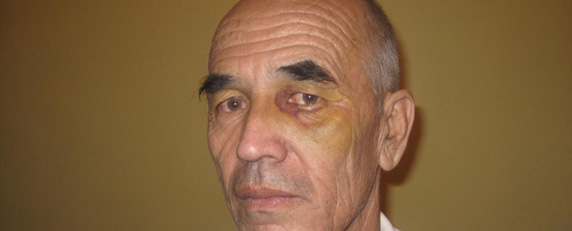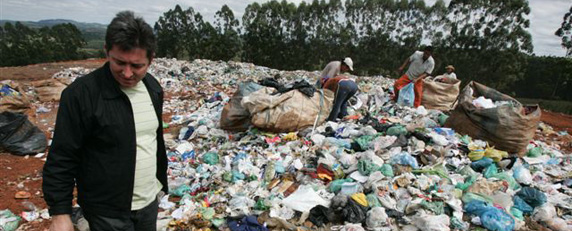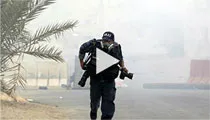Who is allowed to talk? What are they allowed to say? Award winners seek the answers. By Kristin Jones

Harnessing Power in the Stories of Ordinary People
By Kristin Jones
On March 9, 2008, Dechen Pemba, a British-born teacher living in Beijing, boarded an overnight train for Xian, a city about 560 miles to the southwest. She was met there by Dhondup Wangchen, who had traveled from his home in Amdo, a region of the Tibetan plateau that takes up most of China’s Qinghai Province. The two were strangers to each other, linked only by heritage and a loose global network of activists and exiles who hope, in various ways, for a freer Tibet.

Spring starts early in Xian, and the day was bright. When they spoke about the purpose of their meeting, they talked quietly in the Lhasa dialect of Tibetan in the open air and away from passers-by, or in the apartment of a trusted friend of Wangchen. They were being followed, maybe. It was hard to know. When Pemba left that evening, she was carrying a bundle of tapes, the final installment of Wangchen’s project for the previous year, with the intention of smuggling it out of the country.
Five months later, the Summer Olympics began. On the same day, Wangchen’s 24-minute documentary, “Leaving Fear Behind,” made its premiere. “I am not an educated man,” he tells the camera. “I have never been to school. However, I would like to say a few things.”
What followed was a series of clandestine conversations made public. Wangchen asked ordinary Tibetans to talk about the Olympic Games, and about China. A monk on an empty road says the Games should stand for freedom and peace, and “as a Tibetan, I have neither freedom nor peace.” A creased old man in a light-starved room says he doesn’t know what to make of the Games. “I feel very uncertain, as though I’m wandering in the dark and don’t know where it’s safe to step,” he said. “I don’t trust the Chinese at all. Not one bit.”
Who is allowed to talk, what are they allowed to say, and to whom? In November 2012, CPJ awarded its International Press Freedom Award to four journalists from around the world–Dhondup Wangchen, Mae Azango, Azimjon Askarov, and Mauri König. All four came up against these questions and found their own ways to answer. The stories they ultimately told are the stories of ordinary people–not politicians, not wealthy power brokers, not criminal masterminds. They didn’t rely on databases of stockpiled information. Their sources were people who had something to say about their own lives, and wanted to be heard.
There is power in ordinary voices. That much is clear from the threats and attacks that followed the telling. Part of it–both the power of their work and the reason for the attacks–had to do with the secrets revealed. Mae Azango, one of only a few women working as journalists in Liberia, reported on a brutal initiation rite known to many but kept deliberately hidden. Azimjon Askarov recorded what went on in southern Kyrgyzstan’s detention centers, where people accused of crimes are held without trial. Brazilian reporter Mauri König traveled along the country’s invisible borderlands, where drugs, weapons, and humans are bought and sold and used. Dhondup Wangchen told a story–in contradiction to the one told in the opening ceremony of Beijing’s Games–of an empire’s faltering power to impose happiness through prosperity.
The four journalists were also attacked for who they are. An African woman criticizing her own society. An Uzbek in Kyrgyzstan at a time of ethnic violence. A Brazilian journalist on the wrong side of a border.
Wangchen knew the risks he was taking. Before he even started on his documentary, he sent his wife and children to the Tibetan exile city of Dharamsala, India. Just after he finished filming in March, protests began in Tibet, as the slow simmer of anger against Chinese rule erupted into a boil. All Tibetans came under suspicion.
Police knocked on the door of Dechen Pemba’s apartment in Beijing in July 2008 and escorted her to the airport. The last few months had been frightening ones; she had been stopped and questioned, her apartment searched. At least, she thought, she had the protection of a British passport; being deported wasn’t the worst thing that could happen. “I was more worried for my Tibetan friends,” she said. For them, “terrible things could happen and nobody would even know.”
By that time, Wangchen had already disappeared into China’s prison system.

During the Liberian civil war, Mae Azango spent four years living as a refugee in the Ivory Coast. Some days she went without eating. Walking down the street wasn’t safe. “Someone will come up and slap you,” she said. “They will say, ‘This road is not for you.'”
She could have learned almost any lesson from that. The things she learned were empathy for the most vulnerable people, and respect for her own fight. “When I came back home, I lived a poor life,” Azango said. “I know what it feels like. That’s why I have so much passion in reporting on ordinary people.”
Azango has written about sexual violence, poverty, police brutality; she writes about things she wants to change. It was natural that she would write about female genital cutting. Girls who go through the initiation rite, common in the Sande society in Liberia, are told never to speak about it. Government officials, who sometimes owe their power to the tribal elders who protect the practice, are hesitant to condemn it. The local media won’t touch it.
“Nobody talks about it,” said Azango. “Everybody knows.”
But Azango asked questions, and people began talking. One woman recalled the day, 34 years earlier, when it happened to her: Five women held her down and another cut out her clitoris. “It can hurt much more than delivery pain when they be cutting your clitorises with a knife because they cannot numb the place but only put leaves to cover the sore,” the woman told her, in a story that appeared in March 2012 in FrontPage Africa, the newspaper in Monrovia for which Azango works.
The outrage followed swiftly after publication–not against the practice, but against Azango. She was threatened with violence. People turned up at her office looking for her, and Azango was forced into hiding. It wasn’t that anyone denied the truth of what Azango was reporting. Nobody called her a liar. What they called her was a traitor.
“They say I’m Liberian. I’m African. I should protect our culture. They say I take our culture and serve it up to the white people,” said Azango. “You will see me to be a hero in the Western world. In my home, I’m a violator.”
When FrontPage Africa reports on corruption, or even child prostitution, other media tend to pile on with related stories of their own, says Rodney Sieh, the newspaper’s editor and publisher. But not in this case. Sieh got a call from an editor at another publication. “He told me that we shouldn’t allow white people to come into our country and tell us how to conduct our culture.” Both Azango and Sieh rejected that argument. After all, Azango says, she published the story for a reason: She wanted the practice of female genital cutting to end.
“That is why I use my pen. I believe my pen has the power to make the government shift,” said Azango. If she had been a white woman reporting on it, Azango says, she would have simply been ignored. There would have been no threats. But there would have been no national conversation, either. As it was, the government–called out on the complicity of its silence–spoke out against the practice. Tribal leaders agreed to suspend female genital cutting for four years.
Without enforcement, it’s a long way from the ending Azango wants. But the journalist, who has since emerged from hiding, isn’t done yet. “Push until something happens,” she said, explaining the term behind an acronym. “That’s my motto. PUSH!”

In April 2010, protests in northern Kyrgyzstan led to the ouster of President Kurmanbek Bakiyev and the installment of an interim president, Roza Otunbayeva. The new government proved unable to exert full control, however, leaving space for old tensions to rise to the surface. In southern Kyrgyzstan, a pro-Bakiyev faction worked to consolidate power and came into conflict with an Uzbek minority, prevalent in the region and seen as politically ascendant.
In June, riots erupted in southern Kyrgyzstan, lasting less than a week but taking a brutal toll. By the end, according to Human Rights Watch, 400 people were dead, thousands had been forced from their homes, and Uzbek neighborhoods were in ruins. Most of those killed were Uzbek. Most of those arrested in the aftermath were also Uzbek. One of them was Azimjon Askarov. The unrest and the confusion–and Askarov’s ethnicity–had given his enemies a perfect opportunity to silence him.
Askarov made a living as a painter, depicting pastoral scenes of life in the southern Kyrgyz town of Bazar-Korgon, as well as a series of self-portraits. His face, with its craggy cheeks and bushy eyebrows, was a landscape all its own. In 1998, Askarov learned from a brochure about a new human rights organization and made his way to the nearby city of Jalalabad to volunteer, says Valentina Gritsenko, who had founded the group.
“He was an artist,” said Gritsenko, “really open and sensitive to people’s problems. He could see what was happening around him and wanted to do something.” The painter threw himself into this new project, which consisted of interviewing people who were detained without trial, recording instances of torture, and monitoring treatment of minorities, who experienced frequent, often subtle discrimination. He once succeeded in freeing someone accused of murder by producing the alleged victim, alive; the prosecutor was dismissed. He wrote about a woman who was raped repeatedly during her seven-month pretrial detention; she was freed.
Askarov went on to form a separate local rights group, called Vozdukh, meaning Air. His work was published in its weekly bulletins, and on regional news websites. He upended the careers of police officers and prosecutors. Most of the police in his area were Kyrgyz; many–but not all–of the people whose cases he advocated were Uzbek.
Askarov took photos and video, too, in June 2010 as violence ravaged his town. He visited hospitals, and provided journalists with details about the movement of weapons, as well as police abuses, including two shootings, he told CPJ. On June 15, he was arrested and beaten “like a soccer ball.” He was charged and convicted of complicity in the murder of a Kyrgyz police officer killed during the violence, inciting ethnic hatred, and other crimes. His case was riddled with inconsistencies and heavily reliant on the testimony of police officers who knew the victim and had reasons to resent Askarov.
The painter, human rights defender, and journalist was sentenced to life in prison. Masha Lisitsyna, a lawyer with the Open Society Justice Initiative, is working on a complaint to the U.N. Human Rights Committee calling for Askarov’s release. She visited him in prison, where he is kept in a cold and damp basement cell. Askarov recalled to her the words spoken by a police officer in the first days of his detention: Because of the article criticizing us, we will get even with you. We will make you die slowly. Now we have the opportunity and time to punish you.
In the wake of the violence of June 2010, CPJ has documented the near disappearance of Uzbek-language media in southern Kyrgyzstan. Osh TV and Mezon TV, two independent TV stations with Uzbek owners, were both heavily vandalized and ordered to close, accused of inciting violence. Osh TV resumed operations, but transferred to ethnic Kyrgyz ownership; Mezon TV never did.
Now there are fewer ways to talk, and less to hear.

The border regions of large countries can often be nearly invisible to those in the urban centers. Think of the scrublands and desert of southern Texas or Arizona, where thousands of immigrants each year hope to remain unseen as they travel north. Borderlands–neither here nor there–can also be perfect places to hide crimes.
Mauri König has spent his career illuminating the borders that Brazil shares with its neighbors. In a series of investigations in 2004 and 2005, he was able to map out the routes of child sex trafficking along the borders with Paraguay, Uruguay, Argentina, and Bolivia. In another investigation, he showed how Brazilian police had linked with criminal groups in Paraguay to form a car-theft ring.
In 2000, his work took him to San Alberto, Paraguay, 50 miles from the border of Brazil, where he was investigating the mysterious deaths of teenagers at the hands of the Paraguayan army. Pulled over at an apparent police roadblock, König was dragged from his car and beaten and kicked by three men. One of his attackers wrapped a chain around his neck and tightened it to the point of suffocation. “You will never come back to Paraguay again,” they told him. His camera was destroyed and its film, showing children inside the Paraguayan army headquarters, was unspooled. “Down with the Brazilian press” was scrawled on the hood of his car.
König’s attackers were counting on the protection of the border, even as they were profiting from its porousness. He was on their turf, after all; they thought they could evict him. They weren’t figuring in the ability of news to cross borders, too, to forge a larger global community out of a fragmented and divided population.
The assault on König had the opposite effect from the one intended. It became international news, drawing attention to the story that König was telling: Paraguay’s army had been recruiting underage soldiers. He continued with his reporting and told a complete story, publishing the names of 109 children and teenagers from Brazil, Argentina, and Paraguay–the youngest 12 and the oldest 18–who had died under questionable circumstances while in military service.
The story had real impact. International and domestic pressure on Paraguay led to changes in the army’s behavior. The unexplained deaths stopped, and the national legislature made military service voluntary rather than required. König says the main motivation for his work is to provoke anger, so that his journalism can be a tool for transforming realities and people, for stemming injustice.
“My primary intention is to give visibility to excluded people and their problems, which are in fact the problems of all humanity, only on a smaller scale,” said König. “I write hoping to plant a seed of indignation in each reader, so that each one, within possibility, does something to improve the situation.”
The slim documentary that Dhondup Wangchen made about Tibet in 2007 and 2008 was extraordinary, says Robert J. Barnett, who directs the modern Tibetan studies program at Columbia University. Other documentaries have been complaints about suffering and victimhood in Tibet, appealing for sympathy and for condemnation of the aggressor, says Barnett. Or they’ve been fragments collected by Westerners, in the model of the intrepid outsider braving the dangerous.
Wangchen’s film, instead, poses a question: Do the Chinese state and media represent us?
“It treats Tibetans as intelligent agents in contract with the [Chinese Communist] Party, and invites them to discuss what they think of the contract, and whether it’s kept its promises,” said Barnett. “It’s quite a different way of thinking that we don’t see, and it’s typical of internal discussions.”
The film was made as the Chinese government was cracking down on expression and religion in the eastern Tibetan region where Wangchen lived, which had previously enjoyed more leeway than central Tibet. The end of Wangchen’s filming coincided with the start of protests that swept across Tibet. The answer he found in his documentary–that no, the Chinese state does not represent Tibetans–was the same conclusion that thousands of others were reaching at the same time.
It is hard to know exactly what happened to Wangchen. He has been unable to contact his family; fragments of information have come from Jigme Gyatso, a monk who assisted in making the documentary and has been in and out of jail over the past several years. Wangchen’s family knows that he was sentenced to six years in prison on subversion charges, and that his appeal was denied. His wife, Lhamo Tso, says he has contracted hepatitis B in prison.
Wangchen’s crime was articulating for a global audience what he and others–ordinary people–were thinking. His crime was being one among many.
Tso, an unassuming bread maker and mother of four, now takes his message around the world. “My main concern is for the release of my husband, Dhondup,” said Tso. “But I also talk on behalf of all the prisoners in Tibet, and people who are suffering like me. I talk on behalf of the Tibetan people.”
Kristin Jones is a reporter living in New York. In 2011, she was part of a team that won a Robert F. Kennedy Journalism Award for “Seeking Justice for Campus Rapes,” a collaboration between NPR and the Center for Public Integrity. Jones was CPJ’s senior Asia research associate until 2007.

